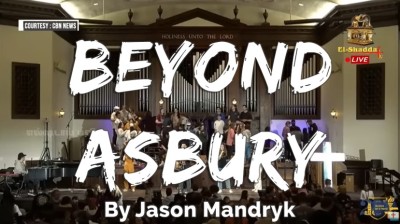Our global God is always on the move, says Jason Mandryk. To take just one example, there is good reason to think there are more than 1 million believers in the Islamic Republic of Iran, he says. And you can be certain that none of them are nominal!

If a revival happens in the forest and no Westerners are around to hear it, does it make a sound?
Such a twist on the old philosophical thought experiment seems timely, given all we hear about the incredible move of God in Wilmore, Kentucky.
Does revival need to happen on a well-lit stage, livestreamed on social media, with people flying in from around the world to attend, and have thousands of articles written about it to count as such?
In the context of majority world Christianity, moves of God tend to happen in places of poverty, persecution, upheaval, and desperation. They are mostly removed from news cameras (for a range of different reasons), and since they unfold outside the Anglosphere, they tend to be off the map for the vast majority of Christians in the West.
What would revival look like deep in the rainforest where there is little to no electricity, never mind 5G? Or in a remote valley amid mountains and deserts where the nearest city is three days’ ride? Or in the churning chaos of a slum with little infrastructure and an endless stream of migrants fleeing drought, flooding, or the latest militia group?
Given that the cultural, social, and economic milieus we are talking about are vastly different from our own, one might expect such spiritual breakthroughs to seem almost alien. But the reality is that the symptoms are remarkably consistent.
When the body of Christ in a community – or across communities – rise early in the morning to pray together for hours, stay up late into the night to worship together (and pray some more), meet together in fellowship several times a week or even every day, find the Word of God coming alive through powerful preaching and personal testimony, confess their sins, cut the ties binding them to their old lives, reconcile to one another, love their enemies, welcome and offer assistance any in need, experience the transforming power of the Holy Spirit, and see unbelievers drawn into their midst to encounter the living Christ – are we talking then about revival?
For all who follow Jesus, the longing to experience revival is a good one. And no place where God moves powerfully could possibly be dreary or dull! But there is – or should be – a degree of normalcy to the body of Christ experiencing the conditions above. If the presence of the phenomena of revival mean that it is revival, then it follows that it is less about profundity or anything extraordinary, and more about believers doing all the things that we wish would happen when revival ‘happens to us’. What we hype up as this elusive, extraordinary state of ‘revival’ should arguably be more par for the course. In his tome on the subject, Barry Chant observes, “Revival is the Church being what it ought to be.”
Perhaps these are truths that we in the global north have lost. As per Luke 6, we are rich, we are well fed, and we laugh often: causes for woe, in Jesus’ own words (perhaps the fact that we are less and less well-spoken of gives us reason for hope!).
No, the places where revival seems to be happening with the greatest frequency are the places where believers have no recourse to anything but God breaking in. They are poor, powerless, harried, under pressure. They gather to pray and fast, to worship, to hear God’s word, to confess and forgive, to share all they have and to be healed by God’s power precisely because they have nothing else they can do and nowhere else to turn.
Allow me to share some examples where such profound breakthroughs are happening. They include sustained church growth amidst persecution, spiritual breakthrough and public proclamation, costly forgiveness, the compulsion to go forth, the inclusion of the least of these, and the presence of relentless prayer.
1. Iran – Sustained growth despite great risk
It has been widely publicised for well over a decade that the church in Iran is growing faster than in any other country.
Iran’s ruthless regime and harsh brand of Islam imposed since the Islamic Revolution have brought about great disillusionment, especially among the younger generation. The body of Christ has suffered under intense persecution. Yet the unrest we see in Iran today is matched by the spiritual hunger of Iranians. Turmoil spreads, but the Church keeps growing!
The underground nature of the Church makes verification impossible, but it is very reasonable to estimate that there are more than a million believers in Iran. You can be certain that none of them are nominal!
2. Thailand – Breakthrough at last?
Thailand has traditionally welcomed missionaries but has also appeared to be resistant to the gospel. Much has been sown into Thailand through prayer and mission but with little fruit. However, in the last few years, the Free in Jesus Christ Association (FJCCA) movement has experienced explosive growth and contextually effective discipleship. Through village-by-village evangelism, thousands of mostly rural house churches have been planted – so many that the relatively new FJCCA has more fellowships than any other denomination or group in Thailand.
Mass public baptisms – the last one including 1,435 new believers – are reshaping the perception and impact of Christianity in this strongly Buddhist nation. Dwight Martin, a researcher who is deeply involved with Free in Jesus, doesn’t call what is happening a church planting movement or a missiological breakthrough, but a revival.
3. Myanmar – Tragedy, terror, and transformation
A number of ethnic minorities in Myanmar (such as the Karen, Kachin, and Chin) have had a strong Church for generations, in contrast to the 95% Buddhist Burmese majority. They, and other groups like the Rohingya, have long been subject to ethnically-targeted violent suppression by the regime.
Since the military coup of 2021, the brutality of the regime has escalated. Churches and schools are targeted by artillery and fighter jets. Some Christians are part of resistance forces fighting against the regime, others are not. But all are subject to the ruthless attacks. Poverty and hunger are commonplace alongside of the atrocities.
Despite the terror and destruction, many thousands are experiencing revival. The faith of nominal Christians is being renewed. The Church is growing and spreading – even Burmese Buddhists are becoming Jesus followers! Amidst terrible suffering, Christians are learning how to live not out of hatred and vengeance, but in Christ’s love that empowers them to forgive even their persecutors.
4. Algeria – From enclave to outreach
The Kabyle are a Berber ethnic group indigenous to mountainous north-eastern Algeria, residing there long before Arabs imposed Islam on the region.
In recent years, the Kabyle have experienced revival that has enlarged the Church among them to tens of thousands of believers – an extremely rare occurrence in North Africa. This outpouring and growth began during the intense Islamist violence of the Algerian Civil War in the 1990s.
Prejudicial treatment, surveillance, church closures, hostility, and arrests have not deterred the Kabyle Church. Not only do they keep making disciples and growing in number, but they are reaching other Berber groups, the Arab majority, and increasingly, sending missionaries to other nations to reach peoples ethnically related to them.
5. India – The least of these
The injustices of India’s caste system, especially for Dalits and Tribal peoples, are well-documented. The large bulk of those who follow Jesus come from the above groups and lower castes.
India’s sex-selective abortion problem and millions of ‘orphans’ demonstrate the lowly status of children, especially girls, who are often considered surplus to requirements. But the younger generation is forming a dynamic part of the growing ranks of the body of Christ in India.
One national leader shared of 170,000 children involved in just one network of kids’ clubs, where they are fed, educated, discipled, and taught to worship Jesus and pray with impressive fervency and authority. This is only one network, operating in only half of India’s states! The same leader shared that spiritual breakthrough and transformation is happening in many parts of India. But the sheer size of India and its population, combined with the security concerns tied to intensifying Hindutva-driven persecution, mean that many of these breakthroughs happen below the radar even of those paying close attention.
6. Africa – Persistent prayer, scaled up
The well-known Holy Ghost Service of the Redeemed Christian Church of God takes place outside of Lagos, Nigeria on the first Friday of every month, beginning at 7pm and lasting through the night. Attendance has been known to exceed one million people – the musicians and singers alone number in the thousands!
Heaven’s Gate Prayer Mountain in Kenya is near to Elementaita (“place of dust”), and is a retreat centre for prayer and fasting. Food is not permitted on the premises. It can accommodate 2,000-3,000 people. It operates year-round, but at peak times, it overflows and people are begged to stop coming. They sleep on the ground and pray in the fields if there is no more room.
Mount Ambericho in Ethiopia was home to a line of witch doctors for centuries until one of them turned to follow Christ. Others followed suit. The crowds who gathered every year to worship the witch doctors began to come to worship Christ. As many as 100,000 climb the 9,900-foot mountain for a whole day of prayer.
Closer to home, Black churches in the UK gather for prayer with a fervency and in numbers that should humble the rest of us. Whether Friday night prayer meetings or New Year ‘Crossover Services’ or city-wide/national prayer events, corporate prayer has long been a strength of Black churches. Swiss theologian Walter Hollenweger noted, “Christians in Britain prayed for many years for revival, and when it came they did not recognise it because it was black.”
GOD ON THE MOVE
No doubt some would disqualify each of these from fitting into their rigid criteria for revival. In his upcoming book Prayer Power – Changing the World and You Stuart Robinson writes, ”Attempts to agree on a concise definition of what is our meant by expectations of revival, would seem to have as much hope of success as David feeling comfortable in Saul’s armor.” Others would assert that insisting on Western definitions and concepts for revivals or any other move of God is yet another example of colonialism in a global Church.
How much do definitions matter? In each of these examples there is a strong sense of – and hunger for – God’s presence. The Holy Spirit is clearly at work, bringing new vitality to God’s global Church and extending his kingdom into communities hitherto deprived of the good news. But the common threads of prayer and fasting, poverty, persecution, and close community confront our materially comfortable, individualistic Western churches.
We say we long for revival. What price are we willing to pay?
Jason Mandryk was born, grew up, and studied in Canada before moving to the UK to join the Operation World team. For over 20 years, he has served through multiple editions and publications of this ministry, as researcher, editor, author, and co-director. He is currently based in Seoul, South Korea. Jason also serves on the Exec Team and Council of International Prayer Connect.
Source: IPC Prayer





